Of the three types of venomous snakes in Pennsylvania, the copperhead is the most common. Copperheads live in wooded areas or rocky landscapes, which are plentiful in Pennsylvania. These snakes avoid open fields or broad valleys. Instead, they prefer areas with plenty of crevices to ambush prey or hide from predators. While this snake’s bite may be intimidating, copperheads are shy snakes and usually only bite as a last resort. To avoid bad encounters with copperheads, residents should learn when Pennsylvania copperheads are most active and how to approach them.
About Copperheads
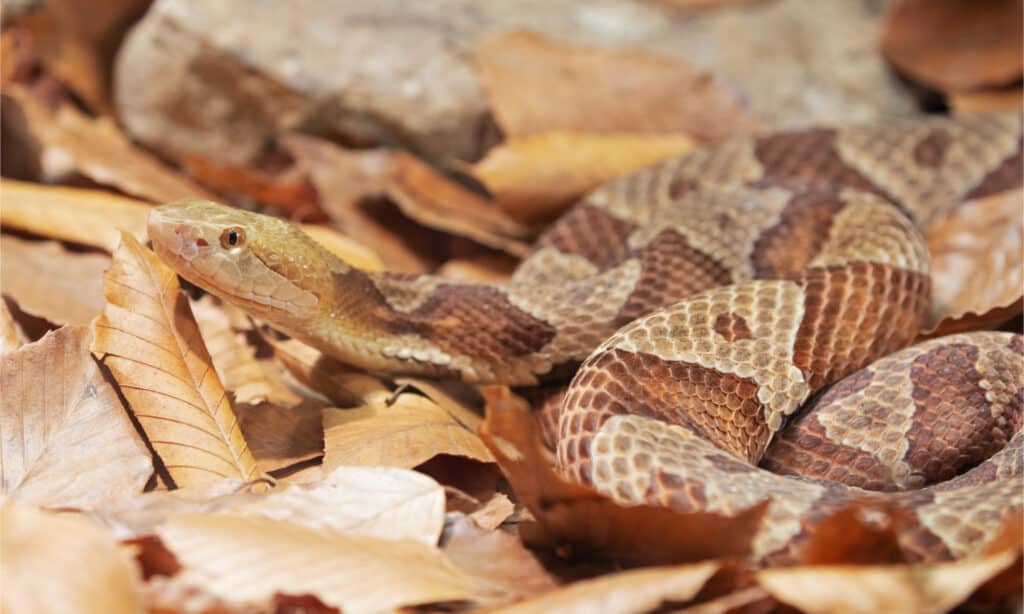
Copperhead snakes have elliptical, vertical pupils, much like a cat’s pupils.
©DnDavis/Shutterstock.com
These snakes get their name because their heads are colored like an old copper coin. Their heads are broad and triangular, while their bodies feature hourglass-shaped bands along the body. Copperheads typically grow 24-36 inches in size but only weigh around 0.5-0.75 pounds.
Copperheads are pit vipers, which means they have unique heat sensor “pits” on either side of their heads. This heat sensor helps them distinguish between heat sources, allowing them to strike at prey precisely.
While copperheads are solitary hunters, they hibernate with other snakes, such as the timber rattlesnakes that inhabit Pennsylvania. Copperheads can reach a speed of up to three miles per hour but usually rely on the ambush technique when catching prey. They feed on rabbits, mice, toads, insects, and other small animals. But, there are a couple of key times when copperheads are active in Pennsylvania.
Where in Pennsylvania Are Copperheads?
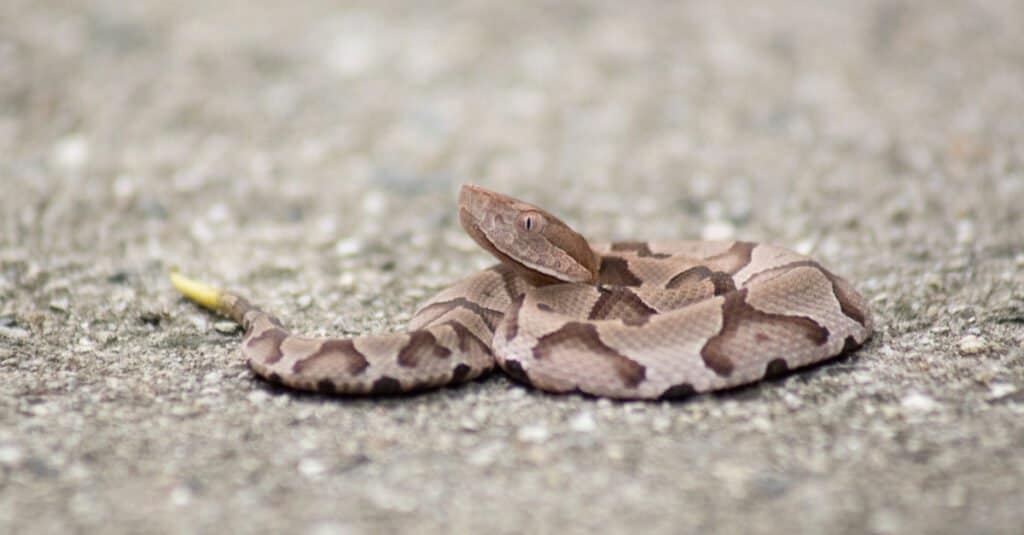
Copperheads are active in Pennsylvania except for the most northern counties.
©woodphotography LLC/Shutterstock.com
These snakes are found throughout Pennsylvania except for the northern tier counties, such as Erie, McKean, Potter, Tioga, and Bradford. Although, there hasn’t been a confirmation that copperheads are in central county Snyder either. But the rest of the state, especially the southern half, has thriving populations of copperheads. As mentioned earlier, copperheads flourish in forests and dynamic landscapes. So, the sprawling forestry and wooded mountains of Pennsylvania are where copperheads are most active.
When Are Pennsylvanian Copperheads Most Active?
Activity for copperheads is usually April through early November in Pennsylvania. They hibernate during the winter and don’t usually travel more than a few miles from their wintering dens.
When it gets sweltering in the summer, copperheads switch to being nocturnal. Copperheads find the temperate nights pleasant, and their heat-sensor pits help them catch prey in the dark.
Mating season is another time when Pennsylvania copperheads are most active, and they usually mate in late spring or early fall. Female copperheads are ovoviviparous, meaning the female incubates the eggs inside its body, and the baby snakes are born live.
After mating in the spring, females will give birth to 1-14 young in the late summer or fall. And, if the female mates in the fall, she will store the sperm and fertilize the eggs after hibernating through the winter.
All in all, the winter months are when copperheads are the least active in Pennsylvania. If you have trepidations about copperhead snakes, winter in Pennsylvania is the safest time to explore outdoors. But copperheads are very docile snakes, so you should also be quite safe hiking in the summer.
Are Copperheads Dangerous?

Pennsylvania copperheads are most active in the months of April through early November.
©iStock.com/David Kenny
Copperheads are responsible for the most human bites per year in North America. There are two possible reasons for such high incidents of copperhead bites. For one, copperheads tend to flee if they hear a human, but if that’s not an option, a copperhead will freeze. And because of their stellar camouflage, this will often result in someone unknowingly stepping on them. Also, when a copperhead feels threatened, it usually does a “dry bite” or warning bite with no venom. If that doesn’t work, a copperhead will bite a second time with venom. That is why, even though copperheads have the most bite incidents of any other venomous snake, the attack is usually not lethal to humans. But overall, these snakes prefer to flee human interactions and are considered to have low aggression.
Copperhead Bites
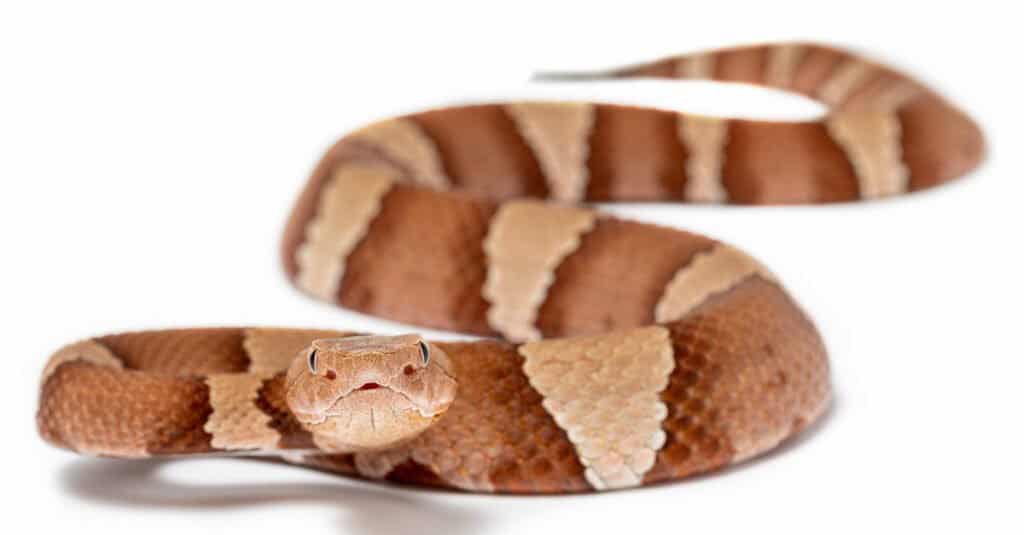
Copperheads tend to be active at night during the summer in Pennsylvania.
©Scott Delony/Shutterstock.com
While copperhead bites are undoubtedly painful, they are not deadly in most cases. In fact, you are nine times more likely to die from a lightning strike than from a snake bite. A lethal bite from a copperhead is about 100mg of venom, but they rarely yield that much venom when they strike. Usually, they are using enough venom to kill a mouse or frog, which, while excruciating for a human, isn’t fatal.
Copperheads have hemotoxic venom, which breaks down the red blood cells. The end result for the snake’s prey is that the mouse experiences internal hemorrhaging, tissue damage, and organ failure.
But, if treated promptly, a copperhead bite usually doesn’t result in any major harm. For instance, this Pennsylvanian woman was bitten by a copperhead who had climbed onto a shelf in her basement laundry room. The woman recovered well, and the snake was relocated to a safer place. But stories like this one are rare. Only about 2,920 people are bitten by copperheads annually in the United States. Considering that about 332 million people live in the United States, that’s very rare indeed!
What to Do If Bitten by a Copperhead
While other snakes will give a warning, like a rattlesnake’s tail buzzing, a copperhead strikes out as a warning. Usually, the first warning bite is a “dry bite” without venom. But you should still get checked by a medical professional after being bitten. Low amounts of venom may cause tissue damage, which a doctor should treat. And, if it was a high dose of venom, a medical facility will administer anti-venom.
What to Do If You See a Copperhead
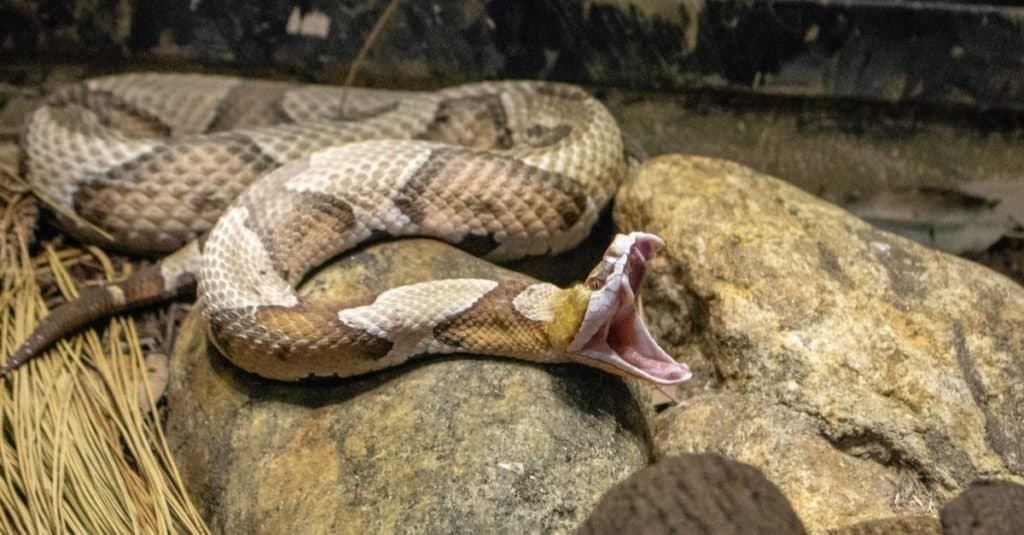
When you encounter a copperhead in Pennsylvania, stay about 2-2.5 feet away from it.
©Suzanna Ruby/Shutterstock.com
If you see a copperhead, the best approach is to keep your distance. Stay out of striking distance, about the length of the snake’s body (2-2.5 feet away). When traveling trails, scan the area and bring a walking stick to make noise as you move. The noise from the stick will usually scare the snake away. Copperheads enjoy overhanging rocks, fallen logs, and any cozy, dark place where they can ambush prey or hide from predators.
On the whole, copperheads are pretty docile. Julian Avery, associate research professor of wildlife ecology and conservation at Penn State, even recounts accidentally walking by a copperhead that was three inches away without incident.
Benefits of Copperheads in Pennsylvania
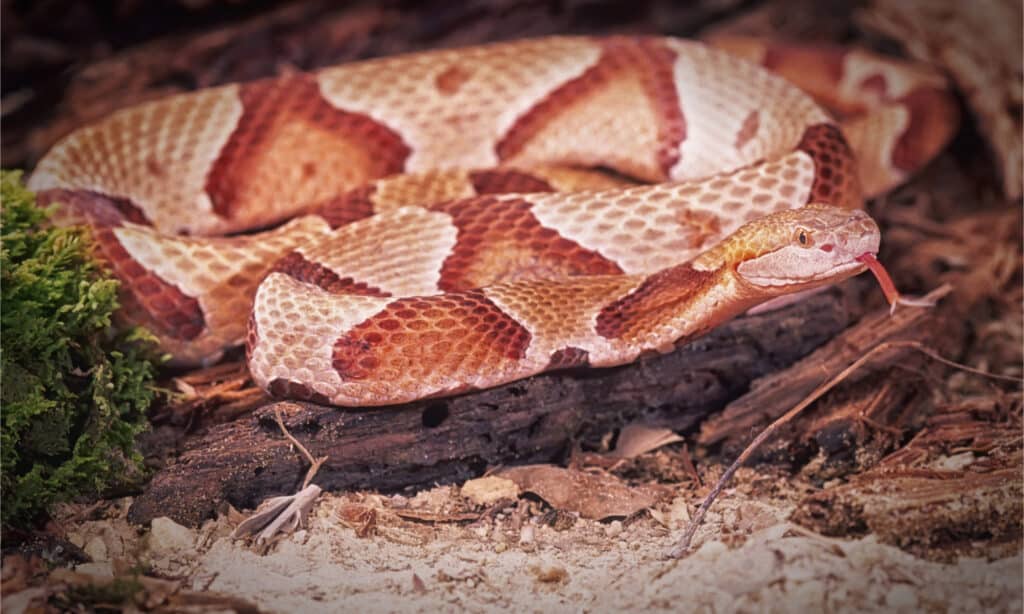
Copperheads do offer benefits, including controlling the rodent population.
©outdoorsman/Shutterstock.com
Because copperheads aren’t aggressive, if you see one, they will probably flee or hold still and hope you don’t see them. And having them in the area helps with pest control. Copperheads eat a lot of mice and other rodents you don’t want in your house, as well as other snakes. And they are also getting rid of the ticks typically found on mice and rats. Ticks carry diseases such as Rocky Mountain spotted fever or Lyme disease.
In conclusion, snakes are incredibly beneficial for managing rodent populations and other pests. Also, snake venom has been used in a lot of medical research. For instance, the blood-pressure medicine ACE inhibitor was inspired by snake venom. When the inhibitor first came out, its ingredient, captopril, was based on a Brazilian viper’s venom. In fact, researchers also explored ingredients in snake venom to combat COVID-19. Research continues for new medical uses of snake venom. Snakes continue to benefit us, even in ways we may not have anticipated.
Discover the "Monster" Snake 5X Bigger than an Anaconda
Every day A-Z Animals sends out some of the most incredible facts in the world from our free newsletter. Want to discover the 10 most beautiful snakes in the world, a "snake island" where you're never more than 3 feet from danger, or a "monster" snake 5X larger than an anaconda? Then sign up right now and you'll start receiving our daily newsletter absolutely free.
Thank you for reading! Have some feedback for us? Contact the AZ Animals editorial team.








